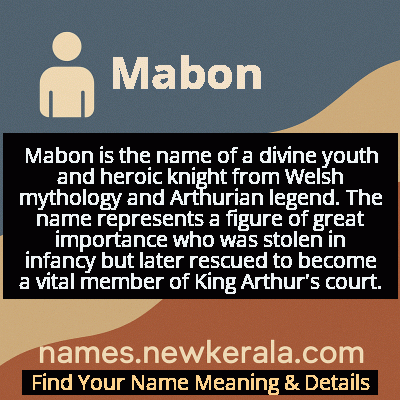Mabon Name Meaning & Details
Origin, Popularity, Numerology Analysis & Name Meaning of Mabon
Discover the origin, meaning, and cultural significance of the name MABON. Delve into its historical roots and explore the lasting impact it has had on communities and traditions.
Name
Mabon
Gender
Male
Origin
Arthurian
Lucky Number
9
Meaning of the Name - Mabon
Mabon is the name of a divine youth and heroic knight from Welsh mythology and Arthurian legend. The name represents a figure of great importance who was stolen in infancy but later rescued to become a vital member of King Arthur's court.
Mabon - Complete Numerology Analysis
Your Numerology Number
Based on Pythagorean Numerology System
Ruling Planet
Mars
Positive Nature
Generous, passionate, energetic, and humanitarian.
Negative Traits
Impulsive, impatient, moody, and can be overly emotional.
Lucky Colours
Red, maroon, scarlet.
Lucky Days
Tuesday.
Lucky Stones
Red coral, garnet.
Harmony Numbers
1, 2, 3, 6.
Best Suited Professions
Military, sports, philanthropy, leadership roles.
What People Like About You
Courage, energy, leadership, generosity.
Famous People Named Mabon
Mabon ap Modron
Mythological Hero
Divine youth figure in Welsh mythology, central to ancient Celtic legends
Mabon fab Mellt
Arthurian Knight
Knight of the Round Table who helped hunt the magical boar Twrch Trwyth
William Abraham (Mabon)
Welsh Politician
Influential trade union leader and MP who improved workers' conditions
Name Variations & International Equivalents
Click on blue names to explore their detailed meanings. Gray names with will be available soon.
Cultural & Historical Significance
The incorporation of Mabon into Arthurian legend, particularly in the tale of Culhwch and Olwen, demonstrates how pagan deities were transformed into Christian heroes during the medieval period. As a knight of Arthur's court who must be rescued to complete a vital quest, Mabon's character preserves ancient mythological themes while adapting to new religious contexts. This dual identity makes Mabon culturally significant as both a reminder of pre-Christian Welsh traditions and an example of how these traditions were preserved through literary adaptation, ensuring their survival into the modern era.
Extended Personality Analysis
Those named Mabon typically exhibit a complex blend of youthful energy and ancient wisdom, reflecting their mythological origins. They often possess remarkable resilience, having the ability to overcome early challenges or periods of feeling constrained, much like the mythological Mabon who was imprisoned but eventually freed to fulfill his destiny. This creates individuals who understand struggle but maintain optimism, combining the innocence of youth with hard-won maturity in a way that makes them both approachable and deeply insightful.
Mabon-named individuals tend to be loyal and dependable, with a strong sense of duty to family and community. They often serve as bridges between different groups or perspectives, much like their namesake connects ancient Celtic and medieval Arthurian traditions. Their personality frequently includes a protective streak, especially toward the vulnerable, and they may find themselves in roles where they help others overcome their own 'imprisonments' or limitations. This results in people who are both grounded in reality yet connected to deeper spiritual or cultural currents, making them natural leaders who guide through example rather than authority.
Modern Usage & Popularity
In contemporary naming practices, Mabon remains a distinctive choice that appeals particularly to those with Welsh heritage or interest in Celtic mythology and Arthurian legends. While not common enough to appear on mainstream popularity charts, it has experienced a slight increase in usage due to the growing interest in mythological names and the neopagan movement, where Mabon is celebrated as the autumn equinox festival. The name is most frequently encountered in Wales and among diaspora communities, though it occasionally appears internationally as parents seek unique names with deep cultural resonance. Its usage reflects a desire to connect with ancient traditions while choosing a name that stands out without being overly obscure or difficult to pronounce.
Symbolic & Spiritual Meanings
Symbolically, Mabon represents the essential journey of separation and return that characterizes many heroic narratives and human experiences. The name embodies the concept of necessary loss leading to greater wisdom and the idea that periods of confinement or challenge often precede significant growth and contribution. As a symbolic figure, Mabon speaks to the universal experience of feeling disconnected from one's roots or potential, and the subsequent process of rediscovery and reintegration that allows for the full expression of one's capabilities.
This symbolism extends to cycles of nature and human life, representing the transition from innocence to experience, the balance between dependence and independence, and the transformative power of rescue and redemption. The figure of Mabon serves as a metaphor for the hidden strengths that emerge during adversity and the importance of community in helping individuals overcome their personal 'imprisonments.' Ultimately, the name symbolizes hope that what is lost can be recovered, often in enhanced form, and that early struggles can become sources of later strength and purpose.

